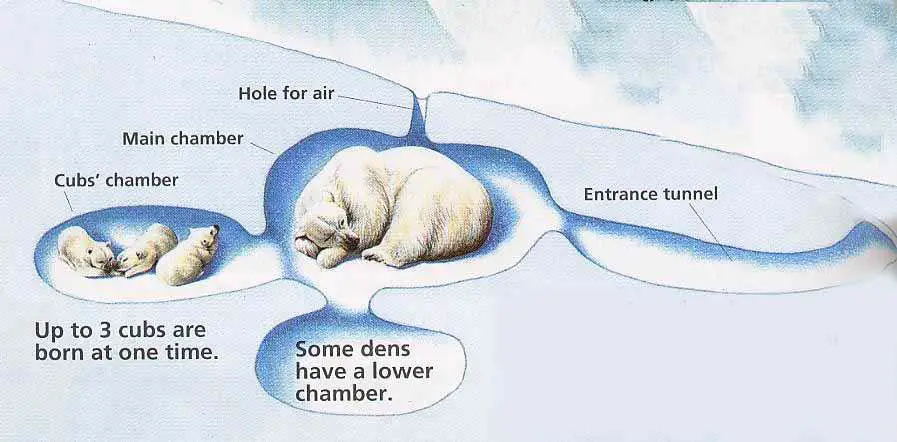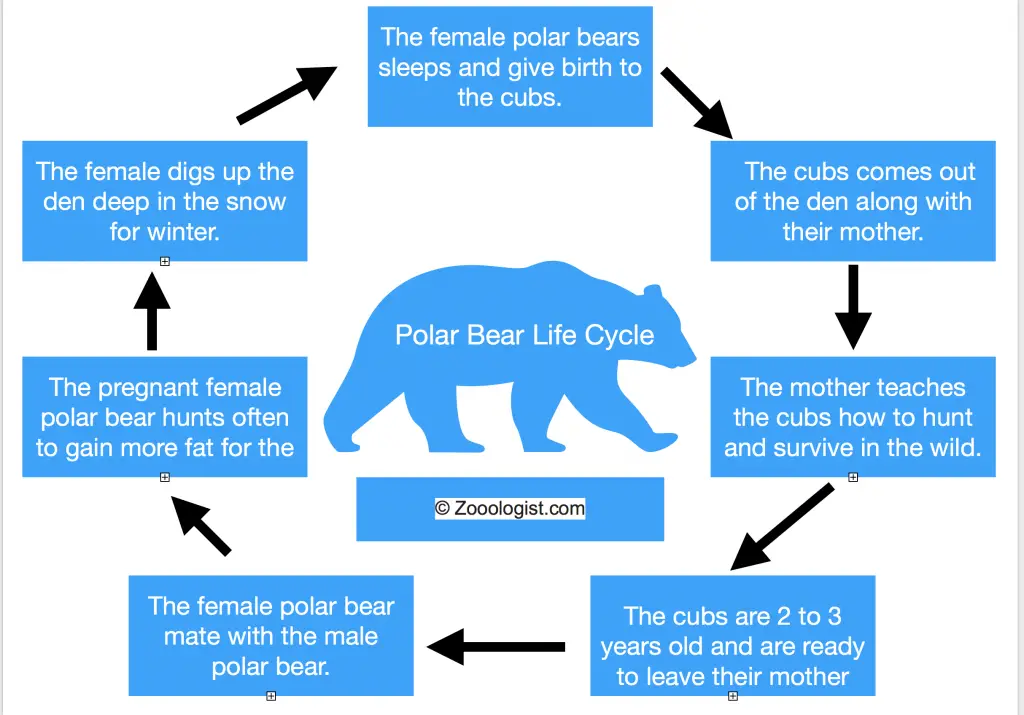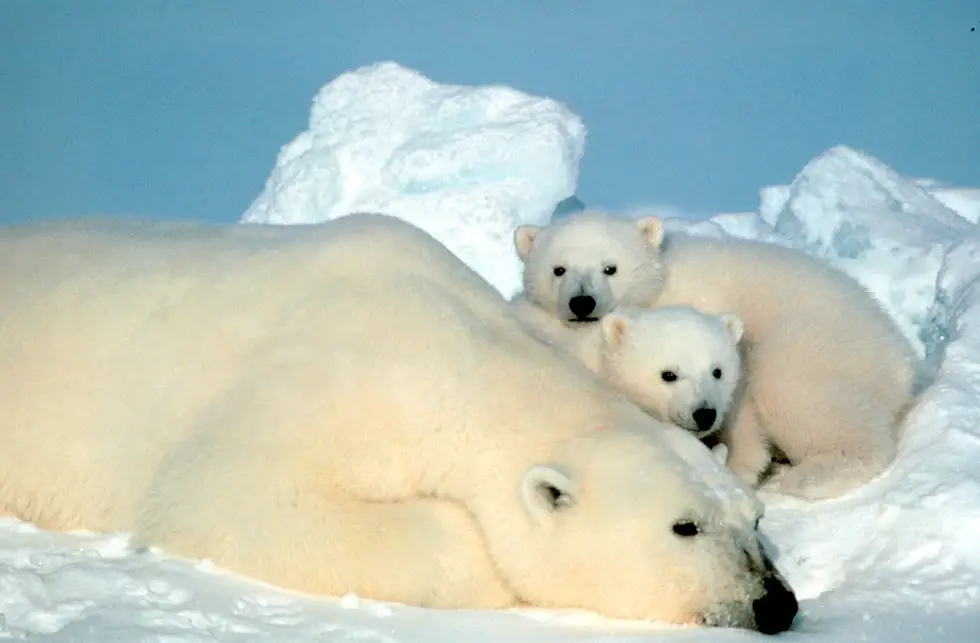In the subject of Biology, Life Cycle of an organism is defined as the series of changes through which that organism undergo throughout its life. Polar Bears like all other living things follow its life cycle from birth to death. Here we have explained the Polar Bear Life Cycle from Birth to Death by identifying each stage along with Polar Bear Life Cycle Facts, Diagram and Worksheet. Do not forget to like and share it with others so that other people can also benefit from this information.
Polar Bear Life Cycle
1. What is the Life Cycle of a Polar Bear
- The life cycle of a polar bear is the series of changes that a polar bear goes through in its life.
- It consists of six different stages:
- Birth
- Childhood
- Adolescence
- Adulthood
- Mating
- Death

2. Polar Bear Life Cycle from Birth to Death – Polar Bear Life Cycle Stages
Stage 1: Birth in Winter
- In the wild, polar bears are mostly born in December. The mother gives birth 1 to 3 cubs at a time. Giving birth to twins is more often.
- The mother along with its cub stay in the den till end of March or start of April. During this period, the mother feed its cub with milk without eating and drinking anything.
- The polar bear cubs when born are about 30 to 35 cm in length i.e. 12 to 14 inches and their weight is about one pound i.e. almost half kilogram.
- When born the cubs have short fur, no teeth and they are completely blind.
- The cubs depend upon their mother for food and heat.
- The cubs’ growth is very fast due to its mother’s fat rich milk (about 31% fat). The mother nurse its cubs for 20 months.

Stage 2: Coming out of the Den in Spring
- The mother polar bear along with its cubs come out of its den in the end of March or early April.
- By this time the cubs have grown enough to survive in the outside world. They are ready to move with their mother towards sea ice where the mother will hunt seals for the family.
- During this stage the mother teaches the cubs about survival in the Arctic.

Stage 3: Growing up
- The cubs stay with their mother for 30 to 36 months.
- During this period they learn how to feed, swim, hunt and survive on their own from their mother.
- Then the cubs reach the subadult age when its time to leave the mother.

Stage 4: Mating in Spring
- Male polar bears get sexually matured between the ages of 6 to 10 years while the female polar bears between the ages of 4 to 6 years.
- Male polar bears start looking for mates from April to June when snow melts down and days are longer. They find female polar bears by following their scented foot trails.
- The female polar bears after mating go through a process called delayed implantation in which her fertile eggs implant only if she has got enough body fat not only to sustain herself but also the cubs during the long denning in winter.
- The male polar bears stay with their mate only for a few days.
- The gestation period for polar bears is 195 to 265 days.
Stage 5: Denning in Fall and Winter
- After mating, the female polar bears feed themselves all the summer to survive the long denning season.
- They start building maternity den before winter where it will give birth to its cubs and nurse them till March or early April.
- The den is usually made in:
- snowdrifts near a coast or river
- in hills near sea ice
- in the snow banks of frozen sea.
- The den is about the size of the polar bear with enough space for it to turn around.
- After the birth of the cubs the Polar Bear Life Cycle completes and that of cubs began to start.
Stage 6: Death
- In the wild the polar bears can live up to 25 years while in captivity they can live more.
- The causes of Polar Bear death includes:
- disease
- accidental
- climate change
- hunting by humans
3. Polar Bear Life Cycle Facts
- A male polar bear follow the scented foot tracks of a breeding female for as far as 100 km i.e about 60 miles.
- A male polar bear will fight with other male polar bears to mate with a female. These fight usually result in broken teeth and scars on the body.
- Polar bears are polygynous i.e. the female mate with more than one male and as a result sometimes the cubs born in a single litter have different fathers.
- The male and female polar bears mate repeatedly for a week to induce ovulation.
- The delayed implantation enable the female polar bears to suspend the fertilized egg till September.
- The pregnant females eats a lot of food to gain 200 kg (i.e. 440 pounds) weight to survive the long denning season.
4. Polar Bear Life Cycle for Kids
- Life cycle is a series of changes in living things from its birth to death. Any living thing including all plants and animals have a life cycle.
- Polar bears are born and feed on their mother’s milk in a den.
- When the cubs are ready to come out of the den they weigh 20 to 25 pounds.
- Their mother will ensure their safety and teach them how to hunt seal and fish they like to eat.
- Then the cubs reach subadult life stage during which they leave their mother but are still unable to have babies of their own.
- During the subadult life the polar bear siblings share their food and live together.
- Female polar bears are able to have babies at the age of four and five while the male polar bears reach maturity at age six.
- When the polar bears are adult the male weighs up to 900 pounds while the female weighs between 300 and 600 pounds.
Learn more: How Much Does A Polar Bear Weigh
- The polar bears mate with each other during the summer season.
- The pregnant female polar bear makes a den in October or November.
- The cubs are usually born in November or December.
- The cubs stay in the den with their mother till March or April.
- In spring season the cubs and the mother come out.
- The cubs stay with their mother till the age of two and a half years. During this time the mother teaches them hunting and surviving on their own.
- Polar bears on average live for 15 to 18 years in the wild. Some can even reach up to 25 years.
5. Life Cycle of a Polar Bear Diagram

6. Polar Bear Life Cycle Pictures
7. Life Cycle of a Polar Bear Worksheet
You can get a worksheet on Life Cycle of Polar Bear by visiting this link: Click Here
Learn more : Polar Bear Facts for Kids







Leave a Reply